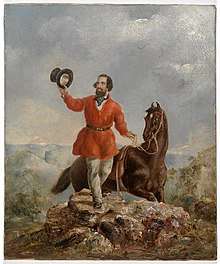Edward Hargraves
Edward Hammond Hargraves (7 October 1817 – 29 October 1891) was a gold prospector who claimed to have found gold in Australia in 1851, starting an Australian gold rush.
Edward Hammond Hargraves | |
|---|---|
 | |
| Born | 7 October 1816 |
| Died | 29 October 1892 (aged 76) |
| Nationality | British |
| Occupation | Commissioner of Crown Lands |
| Known for | Australian gold rush |
Early life
Edward Hammond Hargraves was born on 7 October 1816 in Gosport, Hampshire, England, the son of Elizabeth (née Whitcombe) and John Edward Hargraves. He was educated in Brighton and Lewes, but left school at the age of 14 to go to sea. He arrived in Sydney in 1832.[1]
After his arrival in the colony of New South Wales, Hargraves worked on a property at Bathurst for a period and then went north to the Torres Strait, working in the bêche-de-mer and tortoiseshell industries. In 1834, he took up 100 acres (40 ha) of land near Wollongong. He married Elizabeth Mackay in Sydney in 1836, and in 1839 they moved to East Gosford. Hargraves was an agent for the General Steam Navigation Company and also established the Fox Under The Hill Hotel. In 1843, he took up another property on the Manning River, leaving his wife behind to look after the hotel.[1]
In July 1849, Hargraves left for the United States to participate in the California Gold Rush. He was unsuccessful but returned to Australia in January 1851 with knowledge of prospecting techniques and hopeful of discovering gold closer to home.[1]
Gold discovery
On 12 February 1851 he, with John Lister, William Tom and James Tom, found five specks of gold in Lewis Ponds Creek in New South Wales Australia. Enlisting the help of others to continue the search, he returned to Sydney in March to interview the Colonial Secretary, and, encouraged by his friends at Bathurst, wrote to The Sydney Morning Herald describing the expensive fields.[2]
Aftermath and later life
Hargraves was rewarded by the New South Wales Government for his find – he was paid £10,000 and was appointed Commissioner of Crown Lands. The Victorian Government paid him £5,000. He only claimed £2,381 before the funds were frozen after John Lister protested. An enquiry was held in 1853 which upheld that Hargraves was the first to discover the goldfield. The goldfield, located at Ophir, New South Wales, was named in honour of Ophir.[2]
In 1856, Hargraves purchased a 640-acre (260 ha) landing at Budgewoi on the Central Coast of New South Wales. He went on to build "Norahville" (also called Hargraves House) at Noraville. Wollombi Aboriginal Tribe members are known to have worked on the property. Some sources state that Hargraves had "befriended" the Aboriginal tribe members.
In 1877, Hargraves was granted a pension of £250 per year by the Government of New South Wales, which he received until his death. Shortly before his death in Sydney on 29 October 1891, a second enquiry found that John Lister and James Tom had discovered the first goldfield.[2] Lister is buried in the cemetery at Millthorpe and Tom at Byng, both within 20 kilometres (12 mi) of Ophir.
Hargraves wrote a book about his discovery titled Australia and its Goldfields: a historical sketch of the Australian colonies from the earliest times to the present day with a particular account of the recent gold discoveries, published in 1855.
References
Notes
- Mitchell, Bruce (1972). "Hargraves, Edward Hammond (1816–1891)". Australian Dictionary of Biography. 4.
- Mitchell 1972.
Bibliography
- Evans, Joe. 1988 Gold Gem and Treasure
- Hodge, Brian. "Hargraves, Edward Hammond (1816–1891)". Oxford Dictionary of National Biography (online ed.). Oxford University Press. doi:10.1093/ref:odnb/12314. (Subscription or UK public library membership required.)
- Mennell, Philip (1892). . The Dictionary of Australasian Biography. London: Hutchinson & Co – via Wikisource.
- Mitchell, Bruce (1972). "Hargraves, Edward(1816–1891)". Australian Dictionary of Biography. Melbourne University Press. ISSN 1833-7538. Retrieved 15 March 2008 – via National Centre of Biography, Australian National University.
- Serle, Percival. "Hargraves, Sir Edward Hammond (1816–1891)". Dictionary of Australian Biography. Project Gutenberg Australia. Retrieved 15 February 2007.
- Seccombe, Thomas (1901). . Dictionary of National Biography (1st supplement). London: Smith, Elder & Co.
External links
- Maitland Mercury, 7 May 1851 disputing Hargraves' claims
- Simpson Davison (1860), The discovery and geognosy of gold deposits in Australia: With comparisons and accounts of the gold regions in California, Russia, India, Brazil, &c., Longman, Green, Longman and Roberts